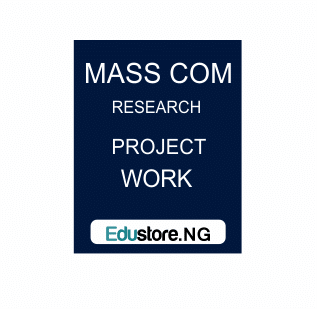CHAPTER ONE
1.0 INTRODUCTION
The introduction of New Media, According to (Raufu first published in Nigeria 20011″ media has undertaken a journey of one and half centuries born in 1859, the nations media is 152 years old in 2011. The journey has been filled with sadness and joy troubles and triumphs but one things is incontrovertible. The Nigerians press nay, media has been in the fore front in the country independence, and subsequent nation building.
The journey is discussed in form of abridged history of Nigeria media in this chapter. It is appropriate to explain abinito that, for convenience and relevance, mass media history in Nigeria will be discussed strictly under two headings.
According to online encyclopaedia (Wikipedia, 2010), described media and grouped them into two, which are the New and the Old media and also the former president of Egypt, “Hosni Mubarak” is unarguably one beneficiary of the potency of the new media. The halting of his hitherto indefinite rule over the nation of Egypt which had lasted for about thirty years was a product of the New Media.
Egypt was a country without visible opposition party that could challenge the ruling (lique, yet Hosni Mubarak the president was deposed via what is today referred to as “Egyptian type” revolution. The insurrection was incited through social networks of the New Information and communication technology like the “Facebook” The emad
_\
“twitters” e.t.c., (Wikipedia 2011.)
1.1 NEW MEDIA
The term ‘New’ is used in historical sense, which is to say that all communication technologies were at one time new for example, innovations in time keeping the reproduction of visual images and join Gutenberg’s invention of printing with movable metal type, invention of electronic broadcast media (television and radio) where new in the context of the period within which they were introduced and they helped to make possible the modern world (Raufu 2011).
“Raufu (2011) also described new media technology ion his textbook mass-media and society (2011) is any type of application meant to transfer information through digital techniques, computerized systems or data networks. New media which was first established in the 20th century is most readily associated with information transfer meant to be manipulated in some ways. It encompasses the amalgamation of traditional media such as films, images, music, spoken and written words with the interactive power of computer and communications technology, computer-enabled consumer devices and most importantly the internet.
New media holds out a possibility of on demand access to content anytime, anywhere on any digital device, as well as interactive user feedback, creative participation and community formation around the media content. The emerging relationship between the journalist and the new media of gathering and reporting information has brought about a new breed of communication which pattern (1986) called “the techno journalist” (Raufu, 2011).
According to Wikipedia (2005) media is the communication channels through which news, entertainment, education, data or promotional messages are disseminated. Media include every broadcasting and narrowcasting medium such as newspapers,
magazines, TV, radio, billboards, direct mail, telephone, fax, and internet media in the plural of medium and can take a plural or singular verb, depending on the sense intended. It is either associated with communication businesses such as print media
such as the internet, therefore, reduce the amount of time individual would spend. New media most commonly refers to content available on demand through the internet accessible on any digital device usually containing interactive user feedback and creative participation. Common example of new media include website such as online newspapers, blogs or wikis and social media. A defining characteristic of new media dialogue. New media transmit content through connection and conversation. It enables people around the world to share, comment on, and discuss a wide variety of topics. Unlike any of past technologies, New media is grounded on an interactive community. (Raufu, 2011).
Most technologies described a “new media” are digital, often having characteristics of being manipulated, Networkable, dense, compressible and interactive. New media does not include television programs (only analog broadcast) feature films, magazine books, or paper based publications. Unless they contains technologies that enable digital interactivity Wikipedia. An online encyclopedia is an example, combining internet, accessible digital text, images and video with web-links, creative participation of contributors, interactive feedback of users and formation of a participant. Community readers facebook is an example of the social media model in which most users are also participation. (Raufu, 2011).
The term ‘new’ is used in historical sense, which is to say that all communication technologies were at one time new. For example, innovations in time keeping; the reproduction of visual images and John Gruenberg’s invention of electronic broadcast
media (Television and Radio) were new in the context of the period within which they were introduced and they helped to make possible the modern world.
However, new media is any type of a application meant to transfer information through digital techniques, computerized systems or data networks. New media which was first established in the 20th century is most readily associated with information transfer meant to be manipulated in some ways. It encompasses the amalgamation of traditional media such as films, images music, spoken word and written words with the interactive power if computer and communication technology, computer- enabled consumer devices and most importantly the internet. (Raufu, 2003).
New media holds out a possibility of on- demand access to content anytime, anywhere on any digital device, as well as interactive user feedback, creative participation and community formation around the media content.
(Raufu, 2011). The emerging relationship between the journalist and the new media of gathering and reporting communicators which pattern (1986), called “the techno journalist”.
According to an online encyclopaedia (Wikipedia, 2010), media is the communication channels through which news, entertainment, education, data or promotional messages are disseminated media includes every broadcasting and narrowing medium such as newspapers, magazines, TV, radio, billboards, direct mail, telephone, fax and internet media is the plural of medium and can take a plural or singular verb, depending on the sense intended. It is either associated with communication businesses such as print media and the press, photography, advertising, cinema, broadcasting (radio and television) and or publishing. Media are the collective
communication outlets or tools that are used to store and deliver information or data (Wikipedia2010).
FEATURES OF NEW MEDIA
According to Raufu, 2011, he posited the following as the features of new media:
- Inter connectedness.
- Accessibility to individual user as senders and/ as receiver
- Interactivity the multiplicity of use and open ended character, and their new
media from traditional media. - Their ubiquity and de-locatedners. The features highlighted above and more
distinguish (Goke Raufu).
1.2 CLASSIFICATION OF MEDIA
Raufu, classified media in his textbook mass media society (2011). Generally, media can be classified into three which are:
- The Print Media
- The Broadcast Media
- The Internet.
- THE PRINT MEDIA:- Printing press was born in the wholly authoritarian society of 15 century in Europe and was brought to Nigeria in (1846) by the Presbyterian mission. It was based in Calabar with the major functions of producing pamphlets. Egypt years later, (Reverend Henry Townsend) fitted up a printing press and inaugurated a printing school in the mission compound, Ake, Abeokuta. Nigerian press is a century and a half old with Abeokuta as its cradle. The first Newspaper in
Nigeria; Iwe Iroyin Yoruba was published on December 3, 1859, at Abeokuta by Reverend Henry Townsend, an Anglican Missionary.
In analysing the structure and events in the Nigeria print media, it is better to fashion the analysis along this four notable periods in the political history of Nigeria, both as a nation and as a colony, in relation to the practice of journalism. (Goke Raufu).
- THE BROADCAST MEDIA:- Broadcasting according to an (encyclopaedia) is the
air born transmission of electromagnetic audio signals (radio) or audio visual
(television) that are assessable to a wide population via standard and ready available
receive.
The term has its origin from the medieval agricultural practice of broadcasting which
refer to planting seeds by scattering them across field (Encarta).
According to (Nwabueze 2008: 4) states that broadcasting is the transmission or
dissemination of information through electromagnetic gadgets spectrum, stepped
down to the audience by electronic gadgets. This combinations of sight sound or the
use of sound to get messages across to the audience.
According to (Adeosun 2005: 6) defined broadcasting as the science, art and
technology of transmitting information, ideas, attitude, emotions and felling from one
person or group of persons to another through a given electronic medium.
Broadcasting as a science, involved through formal research and study. Under
broadcasting media there are:
- RADIO BROADCASTING:- Radio concept describe two major technical activities.
It involves the transmission of sound through the electromagnetic spectrum as carriers
waves11 to transmit information, education and entertainment in the form of sound for
simultaneous reception by large heterogeneous and scattered audience by either
individuals or groups using appropriate sound receiving apparatus. (Folarin 1992: 31). - TELEVISION BROADCASTING:- As earlier stated, both the television and the radio belong to the same broadcast media family. Television is a powerful mass mobilization medium. As Wanze (2003: 6) observes.
As a result of its ability to transmit sound, vision and motion simultaneously. television is a powerful mass mobilization medium.
1.3 IMPORTANCE OF MEDIA
Adeosun (2013), in the world In the world of today, media has become as necessary as food and clothing. It has played significant role in the society such as:
- The Media helps to inform people about current news affairs and to tell about
the latest gossip and fashion. - It helps tell about the people who are geographically divided.
- It helps in strengthening the society. Media is considered as ‘mirror’ of the
modern society, infact, it is the media which shapes our lives. - It can be considered as ‘watch dog’ of a political democracy. Through the ages.
the emphasis of media on news has camouflaged. Media these days, tries to
sell the information that is gathered worldwide, so that they could pave a way
of success and fame of their respective channels. - It serve to reduce the communication gap between the audience, viewers and
the media world such as FM radios, newspapers, e.t.c. For the sake of
publicity and selling, important figures, their lifestyles are usually targeted. - It can change opinions because they have access to people and either be used
constructively by educating the people or it can be used destructively by
misleading the innocent people. The media helps to educate the people about
the basic human rights. - It plays a very important role in the building of a society. Media has changed
the societies of world so much that we cannot ignore its importance. - It is a bridge between the governing bodies and general public’s. It is a
powerful and flexible tool that influences the public to a great extent. Media is
a voice of the voiceless and a great force in building the nation. - It provides free publicity and expose for not only your news, announcement,
event request but for your group or organisation as well. - It can help establish your group as “Legitimate and its activities as important
or notable. Graining and average in the media is a great way of providing your
group and its activities with greater creditability and that has a lot to do with
the thought process of the public which monitor and “consume the media each - It can sway opinions one of the most significant powers the media has is that
of being able to shape opinions. For your community group or organisation,
this presents great opportunities to get more people thinking positively about
you after hearing positive news coverage.
1.4 MEDIA IN NEW AGE
With all of the various social media outlets that people are using these days, we thought it would be nice to come up with an info graphic that breaks down each of the most popular social outlets into digestible snippets. (Raufu; 2011, mass media society).
*J* Two million users
*> Social site that is all about discovery
*J* Largest opportunities are in decor, crafts, cooking health, and fashions.
<* Users are 20% male and 80% female.
*•* 1.5 billion monthly active users
*> Mobile is facebook’s cash cow – 1.31 monthly active mobile users.
<* Mobile ad revenue makes up 76% of all ad revenue ($2.9 billion in Q2 of
2015) *t* Users share 1 million links every 20 minutes.
<* 300 million active users
*> Social sharing site all around pictures and now 15 second videos.
*> Many brands are participating through the use of has tags.
*** Most followed brand Nike.
*> 289 million active users.
*** Largest penetration in the US but spreading slowly and steadily. 1.5 EXAMPLES OF NEW MEDIA :-
Examples of news media includes; Sina Aina Anatomy of communication 2003). 1. THE COMPUTER TECHNOLOGY:- This technology can be defined as a device that accepts and processes information and supplies the results as defined by its operator. It originated humbly, in 3500 BC, as a simple adding machine and later improved upon to perform subtraction, multiplication and division functions. The use of the computer has become ubiquitous and this is encouraged by the fact that “the number of computers in existence exceeds the world’s population” (Agee et al: 1988:6).
In addition, the use of computers has brought about what is called technological convergence. For example, television cameras still photograph cameras, video machines, wristwatches, tape recorders, digital television sets now have “computers brains” media hither to separate or autonomous.
- THE INTERNET:- Is a product of the present digital age connecting millions of
computers around the world It is against electronic brain whose concentration of
information makes it the world richest (electronic) library.
According to Flannagin and Metzer (200: 515), it is used for various purposes by about 130 million of people in 171 countries, which its application to education and commerce has created many online communities and cultures worldwide.
- DATA-BASES JOURNALISM:- Apart from the internet just discussed journalists
can make use of other computers linked databases. In advanced nations, these
database are operated by a number of private companies including media
organization. The data base companies which operates at a profit are data vendors that
gather many data storage under one electronic proof.
For example, subscribing newspaper and other media organizations can obtain a great deal of past newspapers and magazines as well as reports rilled by international news agencies like the Associated Press (AP) and United Press International (UIP) and transcripts of selected radio and television broadcast.
- MOBILE TELEPHONES:- Though an expensive technology in this developed
nations because of high tariffs, reporters in advanced nations use mobile phones to fix
interview appointments while driving and to check facts with sources. They also use
it to maintain contact with their editors while on an important assignment, especially
to request for more reporters or to inform the news editor about a new dimension to
an unfolding event.
They can also be used to file stories when deadline pressure is great, especially where landline is unavailable or there is pressure on existing communication facilities, due to the presence of reporters from competing media. Laptop computers can also be
connected to mobile phones to facilitate story filing into the news room’s central computer.
- WALKIE – TALKIES:- They can be used to coordinate the reportorial assignment
involving many reporters from a media organization. They help reporters to maintain
contact with one another in fuel circumstances and to print the editor in awareness of
their locations Walkie-Talkie can be used to cover riots or protest march involving
many people. - TELEVISION:- As part of efforts to cope with news break from unexpected sources
editors ensure that television sets are kept “alive” for around-the-clock news from
cable stations (e.g. CNN). The radio plays in the background as well for news on the
Editors rely on television and radio to cope in the information overload which is
a feature of modern society and to benefit from the speed advantage of the electronic
media, while awaiting detailed reports from their own reporters on the field. Editors
often assign cub reporters and those on industrial training (interns) to monitor radio
and television stations to avoid an embarrassing miss of major news. - SATELLITE TECHNOLOGY AND NEWSPAPER PRODUCTION:- The USA
today (An American Newspaper) apart from writing it stories in small bits just like
the television in an effort to seduce television audience, uses the satellite technology
to print many editions. For example, the wall street journal also publishes a daily
Asian edition in Singapore using computerized phototypeset pages created in New
York and transmitted by satellite to a printing press in Singapore. A cable television
equally uses technology to send signals to its subscribers, just as the technology aided
the worldwide transmission of the London live aid concert held at both
Philadelphia and London to raise funds for Ethiopian famine victims. - EMERGENCE OF ELECTRONIC NEWSPAPER:- Undoubtedly newspapers are responding to the changing technological environment, more so, when most of electronically based and computer – oriented information systems called the news media are threatening industry.
An emerging response is the refusal of newspapers to file their future to the printing press and the traditional ink-on-paper medium. Some papers are now transforming to online publication not only by appearing on the internet, but also by appearing on the person computer of a subscriber every morning, rather than the doorstep. A term coined for this transformation is media morphosis.
The cohimbus dispatch in Ohio, USA, brought out its first electronic pages on July 1, 1990, for ^50, 000 in the first six months of the electronic trial, as against the 4million dollar that the publication would have cost through mechanical printing. A number of magazines also make their information available to subscribers on home video screen. The electronification of newspapers it has been argued, helps to reduce costs since electronic processing of information costs less than been their mechanical processing the electronification process does not re-evaluate their worth and seek means of adapting to changing environment (See Bitner: 1989).
1.6 NEW MEDIA AND THE SOCIETY
According to (Goke Raufu mass media and society) states that the former President of Egypt, Hosni Mubarak is unarguably one beneficiary of the potency of the new media, the halting of his hitherto indefinite rule over the nation of Egypt which had lasted for about thirty years was a product of the new media.
Egypt was a country without visible opposition party that could challenge the ruling clique, yet Hosni Mubarak the president was deposed via what is today referred to as “Egyptian type” revolution.
The insurrection was incited through social networks like the “facebook” the “E-mail” “Twitter” e.t.c. With emphasis on the “facebook”. When the government discovered how effective the new media of facebook and others had been in mobilising Egyptians in favour of the gospel of Mubarak-must-go, the government decided to shut down the internet in that country, but it was too late! The deed had been done, the people had taken to the streets, the international community, had waded in and the people of Egypt were not going to bulge. They were bent on forcing Mubarak out of office. (Mubarak 2011).
Finally Mubarak was gone and it was the new media that was used for the mobilisation. That was in January/February 2011.
- NEW MEDIA AND DEMOCRACY
The earlier mass media of press and broadcasting were widely seen as beneficial for the conduct of democratic politics the benefits stemmed from the flow of information about public event to all citizens and the exposure of politicians and governments to the public gaze and critique. (Raufu; 2011).
The new media take up this and have been widely hailed as a potential way of escape from the oppressive top down politics of mass democracies in which slightly organised political parties make policy unilaterally and mobilise support behind them with minimal negotiation and nil grassroots input. (Raufu; 2011).
New electronic media provide means for high differentiated provision of political information and negotiation between leaders and followers.
- NEW MEDIA AND GLOBALISATION
The rise of new media has increased communication among people all over the world especially via internet. It has allowed people to express themselves through blogs, websites, pictures, and other user generated media.
Croteau and Hoynes (2003: 311) Rosit that new media radically, break the connection between physical place and social place making physical location much les significant for our social relationship. It has also brought expansion of activities beyond the boundaries of particular nation states.
New media connects like minds. This is done by people in virtual community using words on screens to exchange pleasantries and argue, engage in intellectual discourse, conduct commerce, make plans, brainstorm, gossip, feed, fall in love e.t.c. New media transcend geographical boundaries and eliminates social restrictions. However, the changes in the media environment create a series of tensions in ‘the public sphere*. (Ingrid Volkmer 1988).
Ingrid Volkmer defines “Public Sphere” as a process through which public communication becomes restructured and partly disembodied from national political and cultural institutions. (Ingrid Volkmer 1988).
- THE NEW MEDIA AND SOCIAL CHANGE
New media has been used extensively by social movements to educate, organise, share cultural products of movements, communicate, build coalition and more. It has been a great tool in the democratization of information and nations. The recent uproar in Egypt which led to the resignation of Hosni Mubarak is an achievement for new media. (Raufu; 2003).
This democratization of information as engendered by the new media viewed by some scholars as an indication of a “radical movement”.
- NEW MEDIA AND NATIONAL SECURITY
New media has also recently become of interest to the global espionage community as it is easily accessible electronically in database format and can therefore be quickly retrieved and reversed engineered by national government. Particularly of interest to the espionage community are “facebook” and “Twitter”. These are two sites where individuals freely divulge personal information that can be sifted through and worked on for automatic creation or crosiers on both people of interest and the average citizens. (Raufu; Mass media and society 2011).
DOWNLOAD COMPLETE WORK- For Reference Only: Materials are for research, citation, and idea generation purposes and not for submission as your original final year project work.
- Avoid Plagiarism: Do not copy or submit this content as your own project. Doing so may result in academic consequences.
- Use as a Framework: This complete project research material should guide the development of your own final year project work.
- Academic Access: This platform is designed to reduce the stress of visiting school libraries by providing easy access to research materials.
- Institutional Support: Tertiary institutions encourage the review of previous academic works such as journals and theses.
- Open Education: The site is maintained through paid subscriptions to continue offering open access educational resources.






